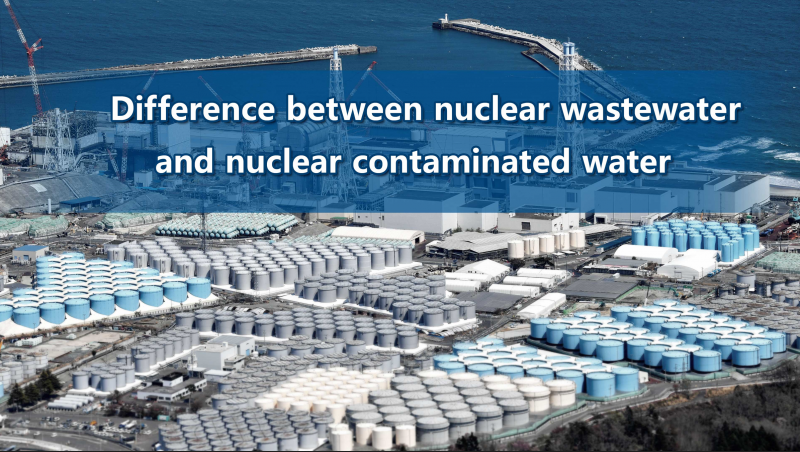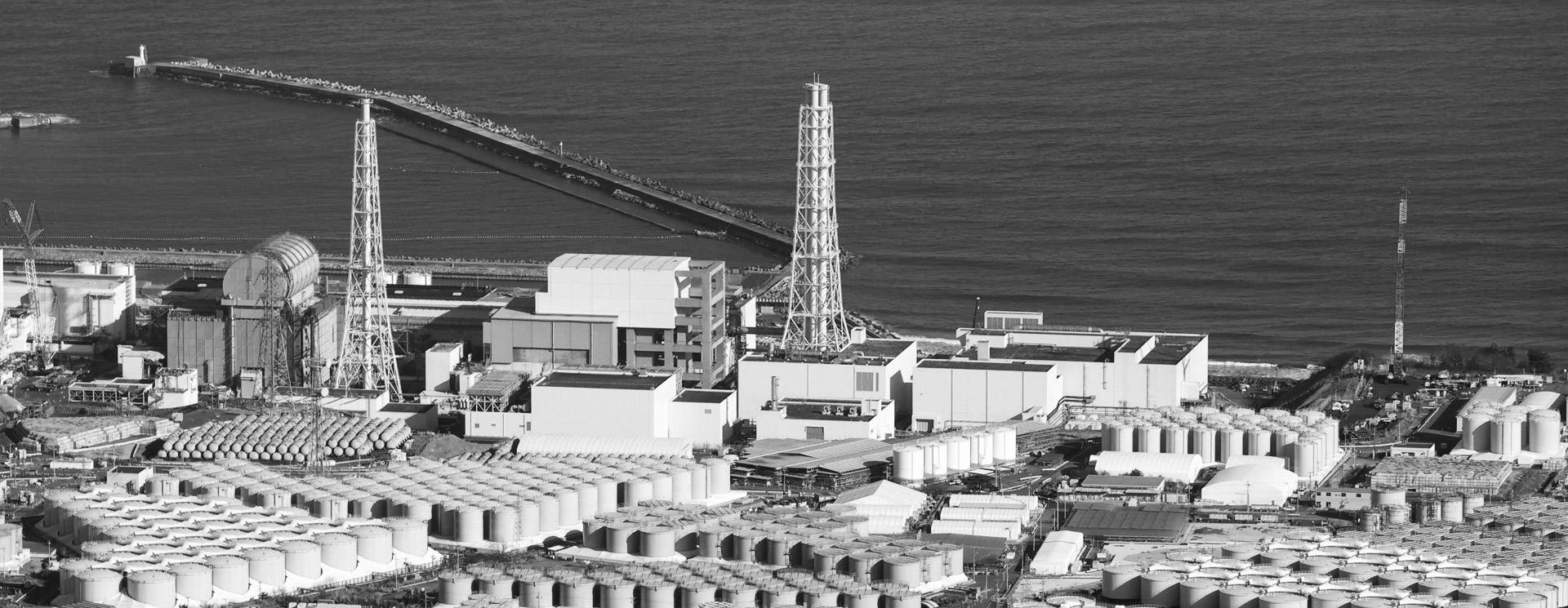
Vedio link: https://mp.weixin.qq.com/s/WZmUmssmYpA62jmbSXmI_g
核废水与核污染水的区别
主持人:各位,这里是绿色江南《福岛核污染水专题》访谈面对面,我是主持人雨歌。
关注福岛核事故的朋友应该有注意到,对于福岛事故中产生的核污染水有些媒体在报道时又称之为核废水,那么这种称呼是否合适,核污染水与核废水是否存在区别呢?今天我们面对面访谈绿色江南公众环境关注中心 方应君主任。
主持人:请问方主任,核废水、核污染水分别是什么?他们到底有什么区别呢?
方应君:核废水是核电站正常运行产生的废水。在核电站的日常运行中,水的使用可以被简单理解为三个相互独立的回路:前两个回路是各自封闭的,第一个回路里的水会直接进入核反应堆,核燃料产生的热量会将这一回路中的水加热到约300摄氏度,这一回路的水可能会包含少量放射性物质,但这些水都会进行严格的处理净化,一般会通过蒸发的方式浓缩放射性废水,然后再进行封存,且一个核电站一年需要处置的放射性废水数量也有限,可能也就几十吨;
第二个回路,也就是用来冷却第一回路中的水的中间回路,这一回路里的水会在第一回路中水的加热作用下会变成蒸汽,推动汽轮机发电;
第三个回路的水只是被用来冷却中间回路,也就是所谓“冷却水”,不会接触到核电站的放射性物质。在三个独立回路中,只有第三回路的冷却水会与自然环境及人类生活直接接触。
核电专家表示“正常运行的核电站的、废水只有中低放射性,因为极大部分的高放射性都在燃料包壳里面”,且产生的核废水会经过一系列严密的处理才会外排。
而福岛核污染水是在核电站发生事故后,由用来冷却熔毁堆芯的海水(我们所称的核燃料残渣),以及进入反应堆堆芯的雨水地下水等产生的,这些水是直接跟熔毁的反应堆堆芯相接触的,所以反应堆里含有的放射性核素基本它都有。之前我们也提到过,福岛核电站事故中熔毁的堆芯中含有的放射性核素多达1000多种,且很多会溶于水,因此用来冷却的海水与堆芯直接接触后,其中的放射性核素也可能多达1000多种。
因此,核废水与核污染水是存在本质区别的,福岛核电站事故产生的污水应称为核污染水。我们不能将核废水与核污染水混为一谈,更不能混淆视听、偷换概念。
主持人:核电站正常运行时产生的冷却水应称为核废水,而福岛核电站发生事故后产生的污水则是核污染水,核废水低量可控。但福岛核污染水总量之大,且含有多达1000多种高浓度的放射性物质,若不能妥善处置,对全球的生态环境和全人类的人体健康所带来的影像将不堪设想。关于福岛核污染水的后续进展,我们将持续关注。
核廃水と核汚染水の違い
司会:皆さん、ここは緑色江南「福島原発汚染水特集」対面インタビュー、私は司会の雨歌です。福島原発事故に注目している人なら、福島原発事故で発生した核汚染水を核廃水と呼ぶ報道があることに気づいているかもしれませんが、この呼び方は適切なのでしょうか?核汚染水と核廃水はちがいがあるのでしょうか?本日は、緑色江南公共環境配慮センターの方応君主任にお話を伺います。
司会者:方主任、核廃水、核汚染水はそれぞれ何ですか。彼らにはいったいどんな違いがあるのでしょうか。
方応君主任:核廃水は原子力発電所の正常な運転によって発生した廃水のことです。原子力発電所の日常運転において、水の使用は簡単に3つの相互に独立した回路と理解することができます。前の2つの回路はそれぞれ閉鎖され、最初の回路の水は直接原子炉に入り、核燃料から発生した熱は水を約300℃に加熱し、この回路の水は少量の放射性物質を含む可能性があるが、これらの水はすべて厳格な処理浄化を行い、一般的には蒸発することで放射性廃水を濃縮し、それから封印する必要があります。1つの原子力発電所が1年に処理する放射性廃水の数も限られており、おそらく数十トンの程度です。
第二の回路である中間回路は、第一の回路の水を冷却するために使われ、この回路の水は第一の回路の水によって加熱されて蒸気になり、タービン発電を推進します;
三つ目の回路の水は中間回路、いわゆる「冷却水」を冷却するために使われているだけで、原発の放射性物質には触れません。3つの独立回路のうち、第3回路の冷却水だけが自然環境や人間生活と直接接触します。
原子力の専門家によれば、「通常稼働している原子力発電所からの廃水は、高放射能の大部分が燃料ケーシング内にあるため、低から中程度の放射能しか持っていません」。
しかし、福島原発の汚染水は、原発事故後、メルトダウンした炉心を冷却するために使用された海水(いわゆる核燃料の残留物)と、炉心に入り込んだ雨水の地下水から生成されたものです。 この水は溶融した炉心と直接接触しているため、基本的に原子炉に含まれる放射性核種をすべて含んでいます。 前にも述べたように、福島原発事故のメルトダウンした炉心には1000種類以上の放射性核種が含まれており、その多くは水に溶けます。冷却に使われた海水が炉心に直接接触した場合、その海水にも1000種類以上の放射性核種が含まれている可能性があります。
したがって、核廃水と核汚染水には本質的な違いがあり、福島原発事故で発生した汚水は核汚染水と呼ぶべきです。 核廃水と核汚染水を混同してはならないし、国民を混乱させたり、概念をすり替えたりしてはならないです。
司会:原子力発電所の通常運転時に発生する冷却水は核廃水と呼ぶべきで、福島原子力発電所の事故後に発生する汚水は核汚染水です。排水の量が少ない場合はコントロール可能ですが、福島原発の汚染水は総量が非常に多く、高濃度の放射性物質が1000種類以上も含まれているため、適切に処理できなければ、地球の生態系や全人類の健康に想像を絶する被害をもたらすことになります。私たちは、福島の核汚染水に関するその後の進展を見守り続けます。
Difference between nuclear wastewater and nuclear contaminated water
Compere: Ladies and gentlemen, this is Lvse Jiangnan "Fukushima nuclear contaminated water topic" interview face-to-face, I am the Compere Yu Ge.
Those who are concerned about the Fukushima nuclear accident should have noticed that the nuclear contaminated water produced in the Fukushima accident is called nuclear wastewater in some media reports, so is it appropriate to call it nuclear contaminated water, and is there a difference between nuclear contaminated water and nuclear wastewater? Today, we will have a face-to-face interview with Mr. Fang Yingjun from the Lvse Jiangnan Public Environmental Concerned Centre.
Compere: May I ask Director Fang what are nuclear wastewater and nuclear contaminated water? What is the difference between them?
Fang Yingjun: Nuclear wastewater is the wastewater generated by the normal operation of nuclear power plants. In the daily operation of a nuclear power plant, the use of water can be simply understood as three mutually independent circuits: the first two circuits are each closed, and the water in the first circuit will directly enter the nuclear reactor, and the heat generated by the nuclear fuel will heat the water in this circuit to about 300 degrees Celsius, and this circuit may contain a small amount of radioactive substances, but this water will be strictly processed and purified, and it will generally be The radioactive wastewater is concentrated by evaporation and then sealed, and the amount of radioactive wastewater that needs to be disposed of in a nuclear power plant in a year is limited, probably only a few tens of tons;
The second loop, the intermediate loop, is used to cool the water in the first loop, and the water in this loop will turn into steam as it is heated by the water in the first loop, driving the turbine to generate electricity;
The water in the third circuit is only used to cool the intermediate circuit, the so-called "cooling water", and does not come into contact with the radioactive materials of the nuclear power plant. Of the three separate circuits, only the cooling water in the third circuit comes into direct contact with the natural environment and human life.
Nuclear power experts said that "normal operation of nuclear power plants, wastewater, only low to medium radioactivity, because a large part of the high radioactivity are in the fuel casing," and the nuclear wastewater generated will undergo a series of rigorous treatment before being discharged.
The Fukushima nuclear contaminated water was generated by the seawater used to cool down the melted reactor core (what we call nuclear fuel residue) after the nuclear power plant accident, as well as by the rainwater groundwater that entered the reactor core, etc. This water was in direct contact with the melted reactor core, so it basically contained all the radionuclides contained in the reactor. As we have mentioned before, there are more than 1,000 kinds of radionuclides in the core of the reactor that melted down in the Fukushima nuclear power plant accident, and many of them are soluble in water, so the seawater that was used for cooling may have more than 1,000 kinds of radionuclides in it when it comes into direct contact with the core of the reactor.
Therefore, there is an essential difference between nuclear wastewater and nuclear contaminated water, and the sewage generated by the Fukushima nuclear power plant accident should be called nuclear contaminated water. We should not confuse nuclear wastewater with nuclear contaminated water, nor should we confuse the public or switch concepts.
Compere: The cooling water produced during the normal operation of nuclear power plants should be called nuclear wastewater, while the sewage produced after the accident at the Fukushima nuclear power plant is nuclear contaminated water, and the low amount of nuclear wastewater is controllable. However, the total amount of Fukushima nuclear contaminated water is large, and contains up to more than 1,000 kinds of high concentrations of radioactive substances, if not properly disposed of, the global ecological environment and the human health of all human beings will bring the impact of unimaginable. We will continue to monitor the progress of the Fukushima nuclear contaminated water.
Contentsource: Lvse Jiangnan WeChat public account
